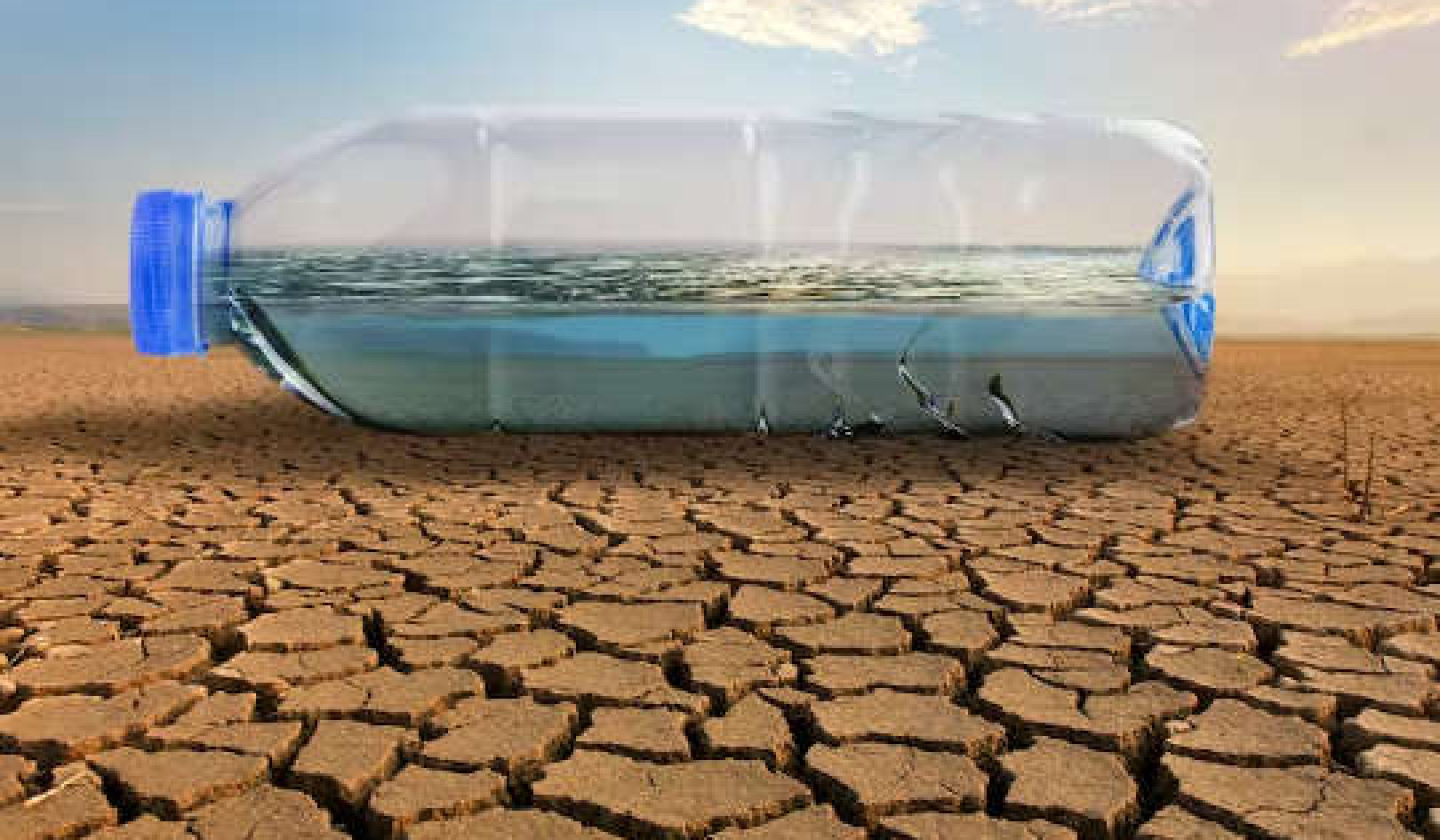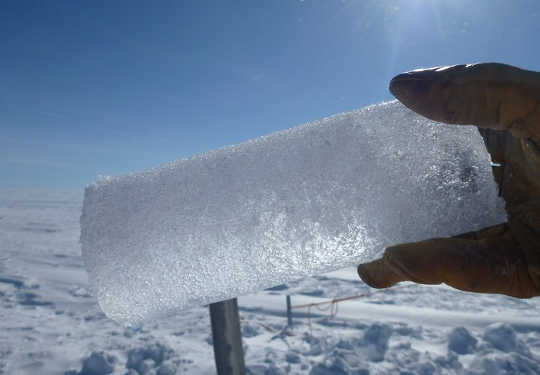
Le carote di ghiaccio sono una finestra nelle ultime centinaia di migliaia di anni. Centro di volo spaziale della NASA Goddard / Ludovic Brucker
There are those who say the climate has always changed, and that carbon dioxide levels have always fluctuated. That’s true. But it’s also true that since the industrial revolution, CO? levels in the atmosphere have climbed to levels that are unprecedented over hundreds of millennia.
Quindi ecco un breve video che abbiamo fatto, per inserire i recenti cambiamenti climatici e le emissioni di anidride carbonica nel contesto degli ultimi 800,000 anni.
youtube} rivf479bW8Q {/ youtube}
The temperature-CO? connection
La Terra ha un effetto serra naturale, and it is really important. Without it, the average temperature on the surface of the planet would be about -18? and human life would not exist. Carbon dioxide (CO?) is one of the gases in our atmosphere that traps heat and makes the planet habitable.
Sappiamo dell'effetto serra per oltre un secolo. Circa 150 anni fa, un fisico ha chiamato John Tyndall used laboratory experiments to demonstrate the greenhouse properties of CO? gas. Then, in the late 1800s, the Swedish chemist Svante Arrhenius prima di tutto calculated the greenhouse effect of CO? in our atmosphere e collegato a glaciazioni del passato sul nostro pianeta.
Scienziati e ingegneri moderni hanno esplorato questi collegamenti con dettagli complessi negli ultimi decenni, perforando le calotte glaciali che coprono l'Antartide e la Groenlandia. Migliaia di anni di neve si sono compressi in grosse lastre di ghiaccio. Il risultato carote di ghiaccio può essere più lungo di 3km e allungare di un anno 800,000 sbalorditivo.
Gli scienziati usano la chimica delle molecole d'acqua negli strati di ghiaccio per vedere come la temperatura è variata attraverso i millenni. Questi strati di ghiaccio intrappolano anche minuscole bolle dall'antica atmosfera, permettendoci di farlo measure prehistoric CO? levels directly.
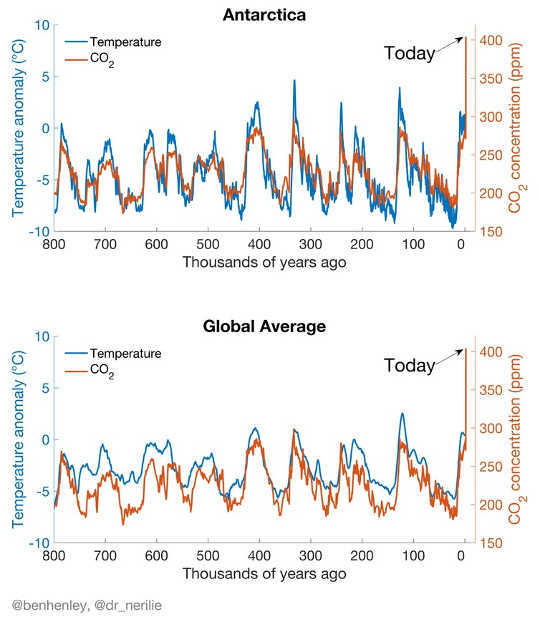 I cambiamenti di temperatura dell'Antartide attraverso le ere glaciali erano molto simili alle temperature medie globali, tranne che le variazioni della temperatura dell'era glaciale rispetto all'Antartide erano circa il doppio di quelle della media globale. Gli scienziati si riferiscono a questo come amplificazione polare (dati da Parrenin et al. 2013; Snyder et al. 2016; Bereiter et al. 2015). Ben Henley e Nerilie Abram
I cambiamenti di temperatura dell'Antartide attraverso le ere glaciali erano molto simili alle temperature medie globali, tranne che le variazioni della temperatura dell'era glaciale rispetto all'Antartide erano circa il doppio di quelle della media globale. Gli scienziati si riferiscono a questo come amplificazione polare (dati da Parrenin et al. 2013; Snyder et al. 2016; Bereiter et al. 2015). Ben Henley e Nerilie Abram
Temperature and CO?
Le carote di ghiaccio rivelano un collegamento incredibilmente stretto tra temperatura e livelli di gas serra attraverso i cicli dell'era glaciale, dimostrando così i concetti proposti da Arrhenius più di un secolo fa.
In previous warm periods, it was not a CO? spike that kickstarted the warming, but oscillazioni piccole e prevedibili in Terra rotazione e orbita intorno al sole. CO? played a big role as a natural amplifier of the small climate shifts initiated by these wobbles. As the planet began to cool, more CO? dissolved into the oceans, reducing the greenhouse effect and causing more cooling. Similarly, CO? was released from the oceans to the atmosphere when the planet warmed, driving further warming.
But things are very different this time around. Humans are responsible for adding huge quantities of extra CO? to the atmosphere – and fast.
The speed at which CO? is rising has no comparison in the recorded past. The fastest natural shifts out of ice ages saw CO? levels increase by around 35 parti per milione (ppm) negli anni 1,000. Potrebbe essere difficile da credere, ma gli umani hanno emesso la quantità equivalente in solo gli ultimi 17 anni.
Before the industrial revolution, the natural level of atmospheric CO? during warm interglacials was around 280 ppm. The frigid ice ages, which caused kilometre-thick ice sheets to build up over much of North America and Eurasia, had CO? levels of around 180 ppm.
Burning fossil fuels, such as coal, oil and gas, takes ancient carbon that was locked within the Earth and puts it into the atmosphere as CO?. Since the industrial revolution humans have burned an enormous amount of fossil fuel, causing atmospheric CO? and other gas serra per salire alle stelle.
In mid-2017, atmospheric CO? now stands at 409 ppm. Questo è completamente senza precedenti negli anni passati di 800,000.
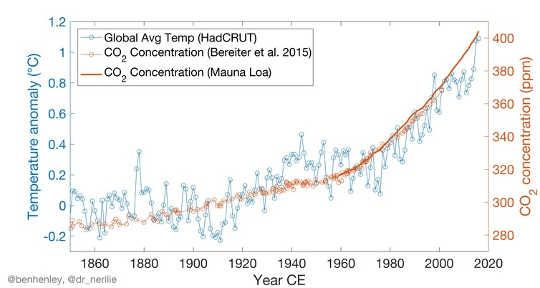 Global Temperature and CO? since 1850. Ben Henley e Nerilie Abram
Global Temperature and CO? since 1850. Ben Henley e Nerilie Abram
I massive blast of CO? is causando il riscaldamento del clima rapidamente. l'ultimo rapporto dell'IPCC concluso that by the end of this century we will get to more than 4? above livelli pre-industriali (1850-99) se continuiamo su un percorso ad alte emissioni.
Se lavoriamo per il obiettivi dell'accordo di Parigi, by rapidly curbing our CO? emissions and developing new technologies to remove excess CO? from the atmosphere, then we stand a chance of limiting warming to around 2?.
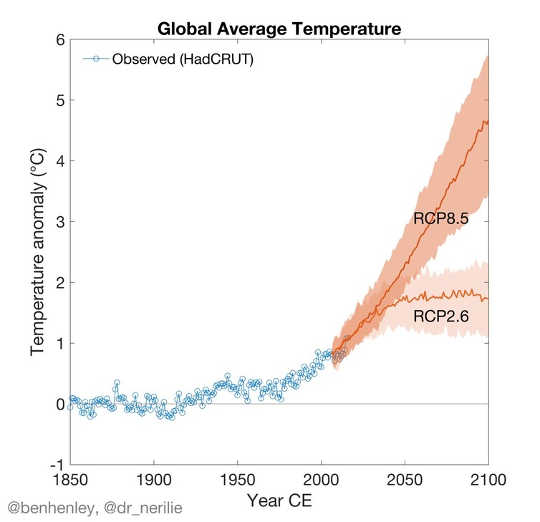 Observed and projected global temperature on high (RCP8.5) and low (RCP2.6) CO? emission futures. Ben Henley e Nerilie Abram
Observed and projected global temperature on high (RCP8.5) and low (RCP2.6) CO? emission futures. Ben Henley e Nerilie Abram
La scienza fondamentale è molto ben compresa. Le prove che il cambiamento climatico sta accadendo sono abbondanti e chiare. La parte difficile è: cosa facciamo dopo? Più che mai, abbiamo bisogno di una leadership forte, cooperativa e responsabile da parte dei politici di tutte le nazioni. Solo allora eviteremo il peggio dei cambiamenti climatici e ci adatteremo agli impatti che non possiamo fermare.
Gli autori riconoscono i contributi di Wes Mountain (multimedia), Alicia Egan (montaggio) e Andrew King (dati di proiezione modello).
Circa l'autore
Ben Henley, ricercatore in risorse climatiche e idriche, Università di Melbourne, Università di Melbourne e Nerilie Abram, ARC Future Fellow, Scuola di Ricerca di Scienze della Terra; Capo investigatore del Centro di eccellenza ARC per gli estremi climatici, Australian National University
Questo articolo è stato pubblicato in origine The Conversation. Leggi il articolo originale.
Libri correlati:
at InnerSelf Market e Amazon



















